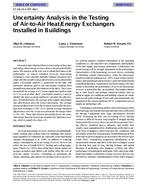Description
Measured data obtained from in-situ testing of heat pipe and energy wheel energy recovery devices are presented in this paper. The purpose of the tests was to obtain field data on the performance of typical installed air-to-air heat/energy exchangers. Since absolute humidity changes measured were small, only the sensible energy effectiveness is presented in this paper. Uncertainty analysis is performed on the data with particular attention paid to the uncertainty resulting from nonuniform temperature distributions in the ducts. These were measured to be as large as 4°C in one supply duct and less than 0.1°C in several other ducts. Uncertainty analysis is used to identify the most accurate method to calculate the effectiveness. In both field tests, the average of the supply and exhaust side effectiveness gives the lowest uncertainty. The average measured effectiveness over the 16-day test period for the heat-pipe heat exchanger is 58% ±11%, and the average measured effectiveness over the 14-day test period for the energy wheel is 74% ±8%. These effectiveness uncertainty levels are somewhat larger than the typical uncertainties for laboratory testing, which is usually less than ±5%.
Units: SI
Citation: Symposium, ASHRAE Transactions, 1998, Vol 104, pt. 1A, San Francisco
Product Details
- Published:
- 1998
- Number of Pages:
- 12
- File Size:
- 1 file , 270 KB
- Product Code(s):
- D-7927




